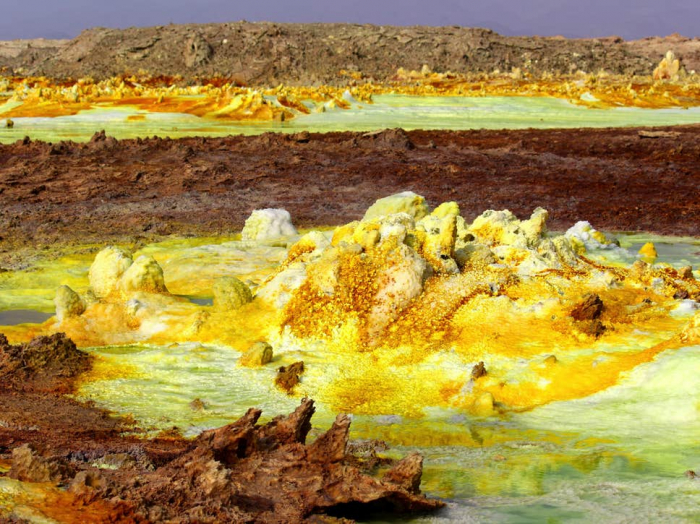Researchers found a strain of bacteria living in temperatures of 89C and extreme acidity of pH 0.25 – conditions similar to those found on the red planet when it first formed.
Samples were collected from around Dallol volcano and Danakil Depression in northern Ethiopia, which is one of the hottest and most inhospitable places on Earth.
“This is an exotic, multi-extreme environment, with organisms that need to love high temperature, high salt content and very low pH in order to survive,” said lead researcher Dr Felipe Gomez, from the Astrobiology Centre in Spain.
The area is saturated in various salts, including silver chloride, zinc iron sulphide and rock-salt which produce a technicolour landscape of yellows, reds, greens and blues. The team collected thin layers of salt deposits and transported them to Spain in sterile, sealed vials.
They were analysed using electron microscopy, chemical analysis and DNA sequencing. The team found tiny, spherical structures within the salt samples were tiny microbes (Nanohaloarchaeles) living in compact colonies. Each microbe was 20 times smaller than the average bacteria.
The Dallol volcano lies 125 metres below sea level and hydrothermal activity is fuelled by water that has been heated by the shallow magma reserve beneath the volcano.
“Deep investigation of the characteristics of this amazing site will improve our understanding of the limits of life on Earth and inform our search for life on Mars and elsewhere in the universe,” said Dr Barbara Cavalazzi, from the University of Bologna.
The area’s unusual geochemistry makes it very similar to hydrothermal environments that would have been found on the Red Planet, including the Gusev Crater, where Nasa’s Spirit Mars Exploration Rover landed.
While the Mars is mostly dry and desolate today, a growing body of research shows it was probably covered in large bodies of water between three and four billion years ago.
“The presence of life in the Dallol hot springs expands our understanding of the limits of habitability on Earth and beyond,” researchers wrote in the paper, published in Scientific Reports.
“However, future work is needed to understand how these nanobacteria survive in such an extreme environment.”
Both Nasa and the European Space Agency are preparing to send rovers to Mars in 2020.
They will roam over the surface and look for evidence of life, either in the past or the present, as well as drilling under the surface in an attempt to pull up any microbial life that might be hiding beneath.
The Independent
More about: Ethiopia
















































